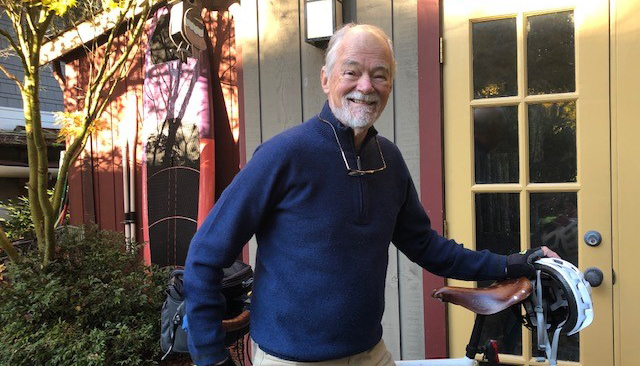For a man who likes working with his hands and who appreciates the meaning of home, a second act as a handyman for HRB’s Independent Living keeps him busy—and fulfilled.
The time had come to stop climbing roofs. Steve Johnson had bagged quite a few peaks as the owner of Bainbridge Solar, but at 79, it seemed foolish to continue. He had liked installing solar panels, in particular the interactions with clients, and he found himself missing that social connection in retirement. When he got word that HRB was looking for skilled handymen for its Independent Living program, Steve decided to get involved.
Independent Living performs health and safety home modifications, free of charge, for income-eligible older adults and people with disabilities who own or rent on Bainbridge. Through measures such as grab bar, handrail, and walk-in shower installation, the program aims to prevent falls and their independence-robbing aftermath and to create a safe and functional environment that allows clients to remain in their homes.
Working with HRB has proven to be very satisfying for Steve. His former solar clients, not surprisingly, were some of the more well-off residents of Bainbridge, and his volunteer work has tended to attract and serve a similar crowd. Although he does not discount the importance of that work to the community, he expresses a preference for his current focus on working for people who for reasons of age or income would not receive these services otherwise.
Steve believes in the mission of HRB, his commitment to affordable housing grounded by his deep roots in the Bainbridge community. He and his wife, Vicky, arrived in the early 70s and started their family here. They paid about $75/month for their “shack” on Pleasant Beach, which has since been replaced with a home more befitting the neighborhood. Steve’s first teaching job took them to the University of Alaska. Twelve years later and tired of Alaska, they wanted nothing more than to live on Bainbridge and be closer to relatives and family there. So, Steve accepted a job as executive director of the Washington Public Utility Districts Association in Seattle which allowed the family to return home.
He bought a house on the island 36 years ago, when the gap between home prices and salaries was not so precipitous. His daughter was likewise lucky, buying her Bainbridge home during the depths of the 2009 recession. But he wants to see factors other than luck—and largess—determine the makeup of the Bainbridge community. He is concerned that the island’s housing market does not allow middle-class people to live here and is dismayed that fire fighters and police officers largely live off island due to the cost of housing. If we were ever to face a natural disaster or other all-hands-on-deck situation, he cautions, Bainbridge would be at a disadvantage.
Over the summer, he replaced a rotting deck for a program participant. She brought him tea with honey and cookies as he worked, and over the course of a few days he listened to her stories of escaping to the West from East Germany with her boyfriend in 1965. A couple weeks ago, he ran into her at Super Suppers and was horrified to see her pedal off on her bike later that night into the rain and dark without any bike lights.
Steve also gets around by bike. In the early 70s, he would bike from Bainbridge to the University of Washington where he was a graduate student in political science. And for 23 years, he commuted by bike to a job in Seattle. So his concern for his client’s safety was well founded. He contacted Independent Living Program Manager Misty Eberspecher to see if the program could cover the cost of a taillight and flasher. She agreed, but as this was not a typical expense, HRB paid for the lights from its general operating fund rather than grant money. Steve installed the lights.
So much of Misty’s work extends beyond the scope of a project. She views her clients holistically, assessing not only what home modifications need to be done, but how they like to live. Where do they read or store their shoes? How do they cook? Do they garden, shop for groceries, or take walks? She uses this information to do more than modify the home, but also to provide lasting and personalized education around fall prevention and general wellbeing, perhaps by instructing them to designate a chair for getting dressed or rearrange a pantry to keep items within easy reach or by urging her clients to get their vision checked or try tai chi at the senior center. This kind of relationship continues well beyond the final touches on a work order.
Though a longtime supporter of HRB, Steve is new to the work of Independent Living, but already he has internalized the program’s ethos. Independent Living does more than create a safe bubble at home within which to contain one’s life but works to preserve health and confidence so that clients can get out into the community and live.
